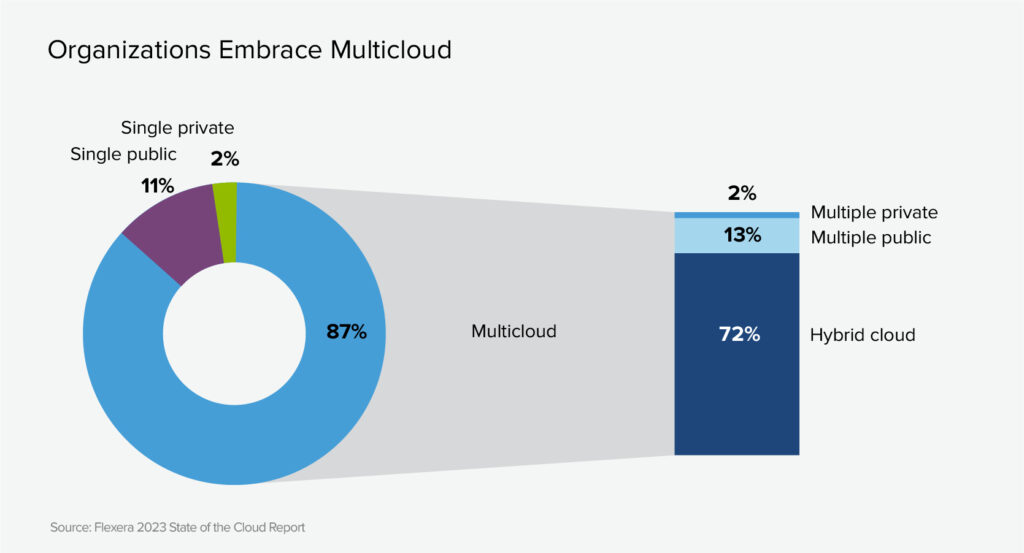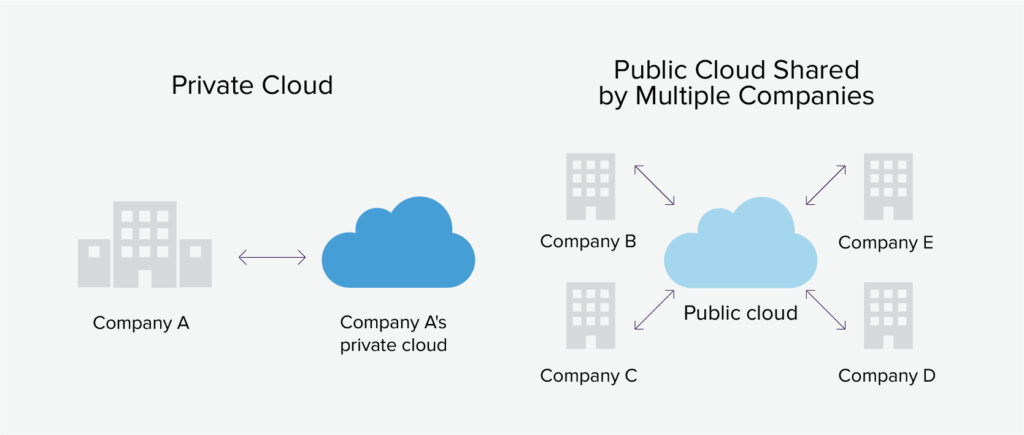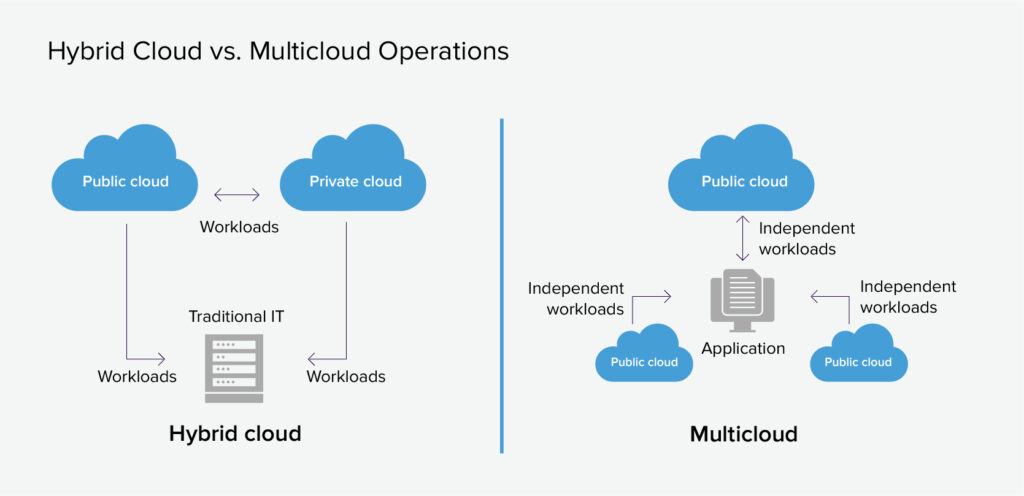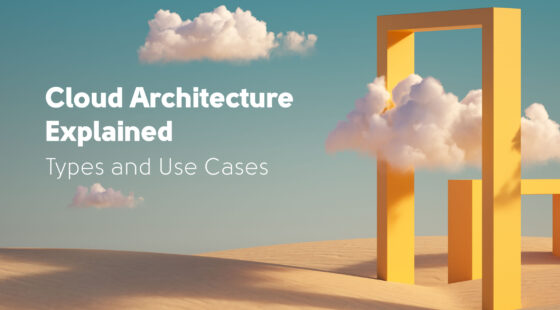If your team’s juggling AWS, Azure, and maybe some on-prem servers, you’re not alone. Most companies don’t stick to just one cloud anymore. According to Flexera, over 72% of organizations use more than one cloud provider. But here’s the catch: using multiple clouds doesn’t always mean you have a multi-cloud strategy. And having on-premise servers doesn’t automatically make your setup a hybrid cloud.

That’s where it gets confusing. What’s the actual difference between multicloud and hybrid cloud solutions? And more importantly, which one makes more sense for your business? This article clears that up. We’ll walk through how each model works, where they overlap, where they don’t, and how to pick the one that aligns with your goals (and your infrastructure realities).
Public Cloud vs. Private Cloud: What’s the Difference?
Before jumping into hybrid or multi-cloud strategies, let’s clarify the basics. Specifically: what's the difference between public and private clouds.

Public cloud = someone else’s data center
Most people picture the public cloud when they think of “the cloud.” You’re not buying hardware, setting up racks, or worrying about cooling systems. You're using infrastructure owned by someone else – AWS, Google Cloud, Azure – and you get access to it over the internet.
You still control your data, your apps, and your security settings. But the physical stuff? That’s the provider’s job. You rent what you need: computing power, storage, and networking. If you need more, you scale up. If you need less, you scale down. It’s flexible, fast to start, and you only pay for what you use.
The “public” part doesn’t mean your data is visible. It just means you’re sharing the underlying infrastructure with other companies, like flying commercial instead of owning a plane. You still get where you’re going, with your seat, baggage, and destination. And if you need more isolation, most providers offer options like dedicated hardware – your own cabin, so to speak – completely separate from other tenants.
For companies in highly regulated sectors, there’s also the option of government clouds – special cloud environments built with stricter access controls and compliance baked in from the start.
Most companies start here because it’s easy to get going. There’s no big upfront investment. No long setup. And when you need access to advanced tools – machine learning, analytics, managed databases – they’re already built into the platform. According to recent research, about 50% of businesses choose the public clouds.
It’s not perfect. And if your industry has strict rules about data security, you’ll need to pay attention to how things are set up. But for many businesses, public cloud is the simplest, most efficient way to build, scale, and stay focused on what matters.
Private cloud = your own sandbox
If public cloud is about renting, private cloud is about owning. You’re not sharing anything here. The servers, the storage, the network – they’re all yours. No one else’s workload is running next to yours.
Sometimes, that infrastructure sits in your building – your own data center, racks, and cables. Other times, it’s hosted off-site by a provider, but still used exclusively by you. Either way, it’s dedicated.
With a private cloud, you’re the one calling the shots. You decide who gets access. You define the security policies. You choose when to patch systems, how to allocate resources, and what kind of workloads run where. That kind of control is hard to beat, especially if you’re in an industry with strict compliance requirements – or if you're working with data that just shouldn’t be anywhere near a shared environment.
This setup also works well for companies with older, critical systems that don’t play nicely with the public cloud. If you’ve got a platform built 15 years ago and no one dares touch the code, moving it to a public cloud can feel risky. Running it in a private cloud gives you breathing room. You get the benefits of virtualization and centralization without forcing a rewrite.
Now, the flip side: private cloud takes work. It usually means hiring (or outsourcing to) people who know how to run it properly. And scaling isn’t as simple as clicking a button – you’re working with fixed resources, not elastic ones. Still, for companies that care deeply about where their data lives, how it’s protected, and who has access to the infrastructure, private cloud offers a level of control that’s hard to match.
Of course, both public and private cloud setups come with a long list of technical nuances, variations, and hybrid options – but that’s beyond the scope of this post. What matters here is understanding the fundamental trade-offs, and choosing what fits your business – not what sounds best in theory.
Difference Between Multicloud and Hybrid Cloud Solutions
Now that we know the basics about private and public clouds, let’s move on to the more complex topic and dive into the concepts of hybrid and multicloud approaches.

What is multi-cloud?
A multi-cloud setup is when you use more than one public cloud provider – say, AWS and Google Cloud. You’re not mixing in private infrastructure here. Just different public platforms, running side by side.
Why would anyone do this? Plenty of reasons:
- One provider isn’t enough. Maybe AWS has excellent tools for DevOps, but Google Cloud wins on machine learning.
- You don’t want to get locked in. If one cloud goes down or prices jump, you’ve got a backup.
- Different teams need different tools. Large companies often default to multi-cloud just because different departments made different choices.
Multicloud gives you flexibility and resilience, but it also adds complexity. More clouds mean more to manage, more billing dashboards, and more governance to figure out.
What is a hybrid cloud network?
A hybrid cloud platform combines your private infrastructure (on-premise servers, private cloud) with at least one public cloud. And the key here is: they work together.
That makes it “hybrid” – it’s not just having both, it’s integrating them. Data and workloads can move between environments. Maybe your website runs in the public cloud, but sensitive customer data stays on private servers.
This setup is perfect if you:
- Have regulatory requirements that say certain data can’t leave your premises.
- Want to gradually move to the cloud, without ditching everything you’ve built.
- Need to burst into the cloud during traffic spikes but keep steady loads local.
But what’s the actual difference between hybrid and multi-cloud? Let’s break it down in plain terms.
| Hybrid Cloud | Multiсloud | |
| What it is | A mix of private and public clouds, working together | Multiple public clouds, working separately |
| Why it’s used | To modernize legacy systems or meet compliance | To gain flexibility, avoid lock-in, or optimize tools |
| Common setup | On-prem + AWS | AWS + GCP (or Azure, etc.) |
| Complexity | Integration-heavy | Coordination-heavy |
| Scalability | Depends on your private setup | Super scalable |
| Security control | High (you own part of the infrastructure) | Depends on the provider, but strong overall |
Can you have both? Totally. You can build a hybrid setup with your private data center and AWS, then use Azure for backups or Google Cloud for analytics. That’s called a hybrid multi-cloud. Most large organizations end up here, even if they didn’t plan it. IT evolves fast, and different needs lead to various clouds.
How to Figure out Which Cloud Setup Makes Sense for You?
There’s no formula for choosing the “right” cloud model. It depends on what your business looks like and what you’re trying to solve. So instead of comparing charts and buzzwords, let’s walk through a few practical questions.
Question #1. What are you putting in the cloud?
Are you just moving files and databases? Running full-blown apps? Looking to host your infrastructure or just use ready-made tools? A hybrid might make more sense if you're lifting and shifting legacy systems or building something custom. Multicloud could be the easier route if you just need reliable services fast.
Question #2. Do things stay steady, or spike?
If your business has predictable workloads, either model can work. But if you have bursts – say, big traffic spikes, seasonal sales, or heavy data crunching – multicloud is easier to scale quickly. Hybrid can handle it too, but only if you’ve set up things like cloud bursting. And that’s not always simple.
Question #3. Does speed really matter?
If you need low-latency, like near-real-time data transfer or app responsiveness, hybrid setups might give you an edge, especially if your private infrastructure is nearby. But modern multiclouds can get surprisingly close, especially if you deploy across regions or use edge services. So, unless you’re dealing with millisecond-level timing, both can usually do the job.
Question #4. What kind of data are you storing?
Sensitive information like healthcare records, financial data, or anything that needs to follow strict regulations? Hybrid’s your friend – it gives you more control over where data lives and who touches it. But don’t write off public cloud: AWS, GCP, and Azure all meet serious compliance standards. If your industry isn’t strict, multicloud can still be safe – and often easier.
Question #5. What’s your budget and team capacity?
Hybrid sounds great until you realize you must buy and maintain your infrastructure. That includes hiring or training people to run it. Multicloud, on the other hand, means paying for what you use. But managing multiple providers, accounts, and tools can get messy fast. So it’s not just about the price, but also what your team can realistically handle.
Question #6. Where’s your team (and your users)?
If you’ve got a remote team, multiple offices, or customers all over the place, multi-cloud can help you stay close to everyone. You can spread your services across different regions and clouds. Hybrid setups aren’t impossible in these situations, but you’ll have to work harder to get global reach with private infrastructure.
Conclusion
Here’s the truth. Most companies don’t choose between hybrid and multi-cloud based on a clever framework or a perfect roadmap. They choose what works with what they already have and where they need to go.
Some have legacy systems they can’t just rip out, so they start with a hybrid. Others have teams scattered across regions, all working with different tools, and end up multi-cloud without even planning it. And then there are those who try to keep things simple, but still land in a hybrid multi-cloud setup because real life happened.
If you're in the middle of figuring this out, you’re not behind. Everyone's cloud journey is messy. The best you can do is make decisions that work for your business as it is now, and set yourself up to adjust later.
If you want help thinking this through – honestly, without the hype – that’s what we do at Svitla Systems. We’ve helped teams simplify their mess, migrate at their own pace, or escape a vendor relationship they’ve outgrown. If that’s where you are, contact us.





![[Blog cover] Cloud vs on-premises security](https://svitla.com/wp-content/uploads/2025/04/Blog-cover-Cloud-vs-on-premises-security-560x310.jpg)